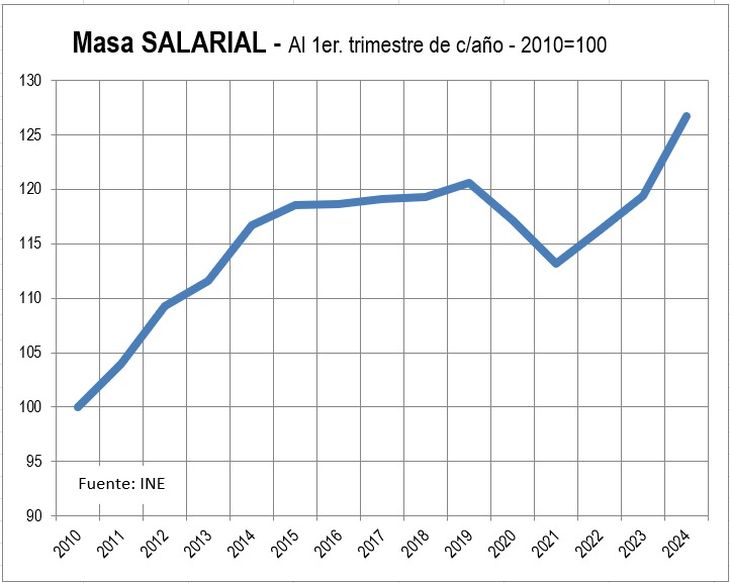Based on the simultaneous increase in employment and salary, this indicator is 5 points above the pre-pandemic level and at its maximum in several decades.
In the first quarter of the year real wages had an increase of 4%, as a result of nominal adjustments that were around 8%, while the inflation It was around 4%. At the same time the employment rate It advanced from 57.5 to 58.7% on the average of the first quarter of 2023 and 2024, respectively. Employment and salary constitute the bases of the so-called wage bill, That is, the aggregate of everything that is paid in the economy in the form of salaries, which is obviously the main income of households. By multiplying both variables, an estimate of the wage bill is obtained, which rose 6% year-on-year in the first quarter, precisely due to the simultaneous increase in employment and wages. In this way, the wage bill is 5% above its pre-pandemic level, and is at its highest in several decades.
The content you want to access is exclusive to subscribers.
This estimate of the wage bill is made based on official data from the National Institute of Statistics (INE). In the case of employment, the data comes from the household survey and indeed – although in recent months it has tended towards a certain stabilization – the year-on-year comparison gives an appreciable increase, as described above. He Average Salary Index (IMS) For its part, it is also prepared by the INE, based on the evolution of salaries in all sectors, including the State. The index exclusively incorporates the formal salaries of the economy.


The calculation that accompanies this analysis does not include the population increase, which in Uruguay It is very modest year after year, something that has been confirmed by recent preliminary census figures. If this factor were incorporated, the calculation would be more exact, although surely without major differences, with an evolution of the wage bill that would be slightly greater.
Salary mass.jpg

The wage bill grew 6% in the first quarter.
Wages and GDP
With the arrival of the pandemic there was a sharp drop in employment and with it obviously the wage bill, although not all sectors were affected in the same way. State workers -obviously- basically kept their jobs and the trance in the construction and industrial sector, in general, was also managed to overcome quite successfully. Once the pandemic was overcome – which lasted until well into 2021 – employment began to improve but salaries were capped in real terms due to the inflationary pressure that occurred in the following months. In effect, annual inflation went from around 7% in mid-2021 to 9% towards mid-2022. We had to wait until 2023 to have nominal wage increases above inflation (real increase) while employment continued to strengthen. There, the wage bill did begin to show progress, but it was only towards the end of 2023 that it equaled its 2018-2019 levels. Already entering this year, 2024, the strong increase in real wages simultaneously with employment that is growing in interannual terms leads to wage bill to the aforementioned historical record.
In all that period that we have gone through in a very general way, the GDP It recovers pre-pandemic levels in 2022 and is even somewhat above it, so that it exceeded the evolution of the wage bill at that time. This changes in recent months; On the one hand, GDP grew very modestly in 2023, due to the well-known effects of the drought and also of impact of the Argentine crisis. Meanwhile, wages and employment continued to advance and already at the start of this year, 2024, the relationship between the wage bill and GDP is two points above its pre-pandemic level. In other words, compared to the situation in 2019, the wage bill increases more than the GDP.
The challenge from now on -among others- is that the economy can sustain this progress, while the reduction in levels of informality, one of the positive trends of the post-pandemic scenario. GDP is expected to grow by more than 3% this year, although some recent estimates are more cautious. Uruguay is with competitiveness problems (general salary cost is one of the factors), the fiscal deficit is high and the regional and global scenario is not so rosy. The advance in the wage bill is objective, but its permanence is not guaranteed.
Source: Ambito




